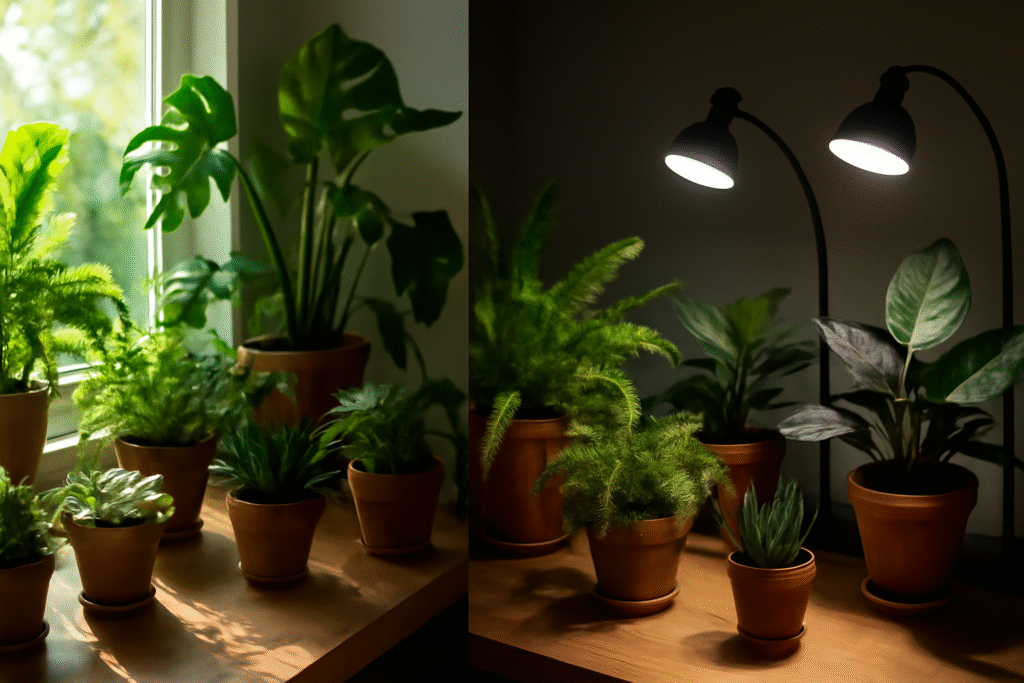
Natural Light vs. Artificial Light for Plants: Which is Best for Healthy Growth?
When it comes to growing healthy, thriving plants, light is a game-changer. 
In this article, we’ll dive into the pros and cons of both natural and artificial light, helping you understand which option is best suited for your plants’ needs. Whether you’re a beginner or a seasoned plant parent, you’ll discover practical tips and valuable insights to ensure your plants get the right light for healthy, vibrant growth. Ready to unlock the secret to happier, more resilient plants? Let’s explore!
Table of Contents
ToggleUnderstanding the Role of Light in Plant Growth
Light is the lifeblood of plants. 
Why Light Matters for Plants
Plants rely on light to produce the energy they need to survive. This process, called photosynthesis, happens in the chlorophyll (the green pigment in plant cells). During photosynthesis, plants take in carbon dioxide from the air, water from the soil, and, most importantly, light from their environment. The energy from light allows plants to turn these ingredients into glucose, which fuels their growth.
Without enough light, plants can’t photosynthesize effectively, leading to weak, leggy growth, yellowing leaves, and even plant death.
The Light Spectrum: What Plants Really Need
Not all light is the same! 
- Blue light (400–500 nm): Helps plants grow strong and healthy by promoting leaf and stem growth. It’s crucial for young plants and seedlings.
- Red light (600–700 nm): Encourages flowering and fruiting. It’s especially important for mature plants and those in the blooming phase.
The combination of both blue and red light is ideal for plant growth, and this is why full-spectrum grow lights are often recommended. These lights mimic the sun’s natural spectrum, providing all the wavelengths plants need for optimal health.
Types of Light for Plants
Now, let’s look at the two main sources of light available for plant growth: natural light and artificial light.
- Natural Light – The sun provides a full spectrum of light, making it the most natural and efficient source of energy for plants. It’s free and abundant, but the intensity and duration of sunlight vary depending on the time of day and seasons.
- Artificial Light – While natural light is ideal, artificial light allows for control over intensity, spectrum, and duration, especially in spaces with limited sunlight. Grow lights like LEDs or fluorescents can be fine-tuned to meet your plant’s specific needs.
Light Intensity: Why It Matters
The intensity of light (how bright the light is) is another factor plants rely on for photosynthesis. Too little light will stunt growth, while too much light (especially direct sunlight) can cause damage, like leaf burn. It’s important to find the right balance. Plants need a good amount of light, but not overwhelming amounts.
Tip: A simple way to measure light intensity is by observing your plant. If your plant’s leaves are turning yellow or brown, it’s likely getting too much light. If it’s stretching or becoming “leggy,” it’s not getting enough light.
Light Duration: How Long Do Plants Need Light?
In general, plants need around 12 to 16 hours of light per day to thrive. However, the quality of light is just as important as the quantity. Too much exposure to intense light can stress your plants, so make sure they also get periods of darkness to rest and reset.
Pro Tip: If your plants are indoors, be mindful of the seasons. In winter, there’s less natural light, which may require you to adjust your light setup or use artificial lights to fill the gap.

Natural Light for Plants
Natural light is the most authentic and beneficial light source for plants. 
Benefits of Natural Light for Plants
- Full Spectrum of Light
The sun delivers the full spectrum of light, from blue and red wavelengths to ultraviolet and infrared. This diverse range helps plants grow strong, produce vibrant leaves, and flower successfully. No artificial light can replicate the sun’s natural spectrum completely. - Energy Efficiency
Sunlight is free! Unlike artificial lights, you don’t need to worry about electricity costs when using natural light. As long as your plants are positioned in a well-lit area, they get all the light they need without added expense. - Supports Healthy Growth
Natural light provides the intensity and warmth that plants love. It stimulates healthy leaf growth, stronger stems, and robust root systems. Plus, many plants—especially tropical varieties—thrive in warm, sunny environments.
Challenges of Natural Light for Plants
- Limited Availability
The biggest challenge with natural light is its unpredictability. Depending on where you live, the intensity and duration of sunlight can vary, especially in winter months. If your plant is dependent on bright sunlight, cloudy days or shorter daylight hours can lead to slower growth. - Seasonal Fluctuations
In the summer, plants might receive plenty of light, but come winter, natural light can become scarce. In colder months, this decrease in sunlight can stress out your plants and lead to leggy, weak growth if they’re not getting enough light. - Risk of Overexposure
While plants love sunlight, too much of it—especially direct, intense sun—can damage your plants. Prolonged exposure can cause leaves to scorch, turn yellow, or even burn. Certain plants, like succulents, need bright light but can suffer from leaf burn if exposed to too much direct sunlight.

Maximizing Natural Light for Your Plants
If you want to give your plants the best chance with natural light, here are some tips for optimizing it:
- Place Plants Near Windows
South-facing windows usually offer the most sunlight throughout the day, while east-facing windows provide gentle morning light. Avoid placing plants near north-facing windows, as they tend to get the least sunlight. - Use Sheer Curtains for Diffusion
Direct sunlight can sometimes be too harsh for your plants. Using sheer curtains will help diffuse the light, giving your plants the sunlight they need without the risk of burning them. - Rotate Plants Regularly
Plants naturally grow toward the light. To ensure even growth, rotate your plants every week so that all sides get equal exposure to sunlight. This helps prevent them from becoming lopsided or “leggy” as they stretch toward the light. - Reflect Light
You can maximize the amount of light reaching your plants by using mirrors or light-colored walls to reflect sunlight. This works especially well for plants placed in lower light areas.
Which Plants Thrive in Natural Light?
- High-light plants: These plants need bright, direct sunlight for at least 6 hours a day. Examples include succulents, cacti, and many herbs.
- Medium-light plants: These plants thrive in bright, indirect light. They may tolerate some direct sun but perform best when placed near a window with filtered light. Examples: snake plants, pothos, and spider plants.
- Low-light plants: These plants do well in areas with little direct sunlight, thriving in low to moderate light conditions. Examples: ferns, ZZ plants, and peace lilies.
Pro Tip:
If you’re unsure whether your plants are getting enough light, pay attention to their behavior. If their leaves turn yellow or they begin to stretch and become leggy, it’s a sign they’re not getting enough light. On the flip side, if you notice scorched or crispy edges on the leaves, they might be getting too much direct sunlight.
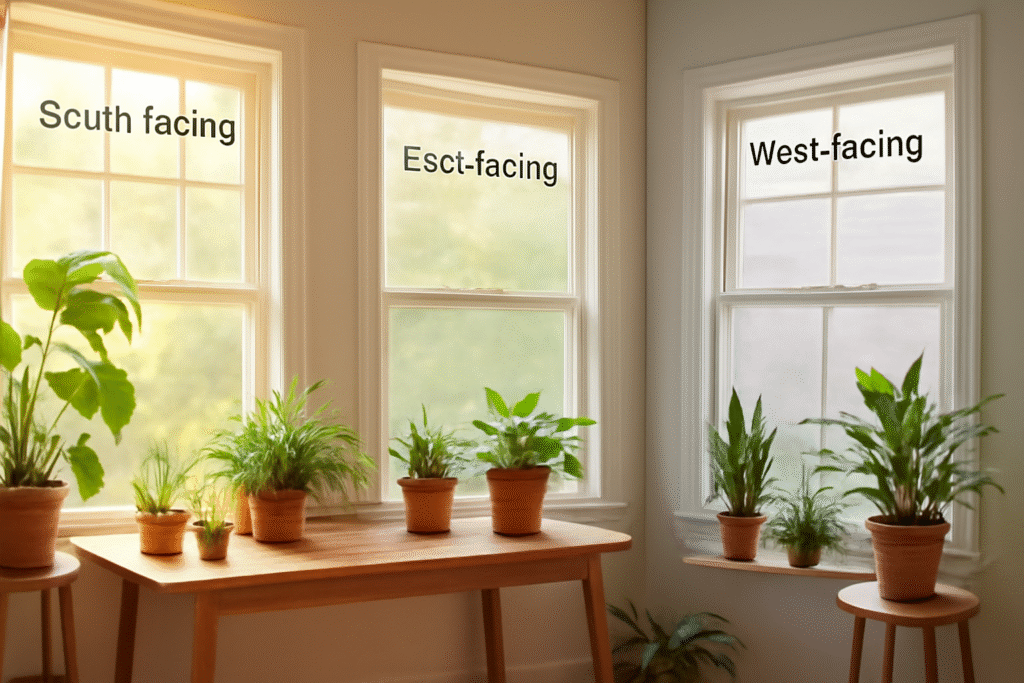
Artificial Light for Plants
When natural light isn’t enough, artificial light can be a game-changer for your plants. 
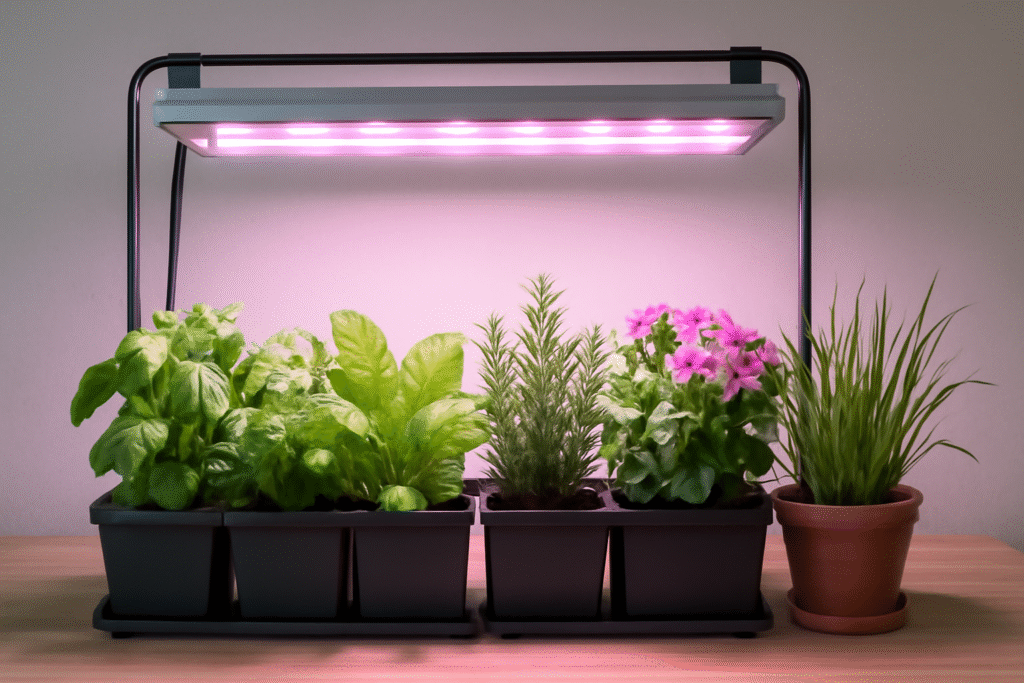
Types of Artificial Lights for Plants
- LED Lights
LED lights are the most popular and efficient option for indoor plants. They are energy-efficient, long-lasting, and can be customized to emit specific wavelengths of light, such as red and blue, which are crucial for plant growth. LED lights are also cooler, so you don’t need to worry about them overheating your plants. - Fluorescent Lights
Fluorescent lights are another great option, especially for low-light plants. They emit a broad spectrum of light and are relatively inexpensive. While they’re not as efficient as LEDs, they still provide sufficient light for smaller plants or those placed further from the light source. - Incandescent Lights
While incandescent bulbs are widely available, they’re not the best choice for plants. They emit more heat than light and produce a narrow spectrum that’s not ideal for plant growth. If you do use them, keep the bulb farther from the plants to avoid overheating.
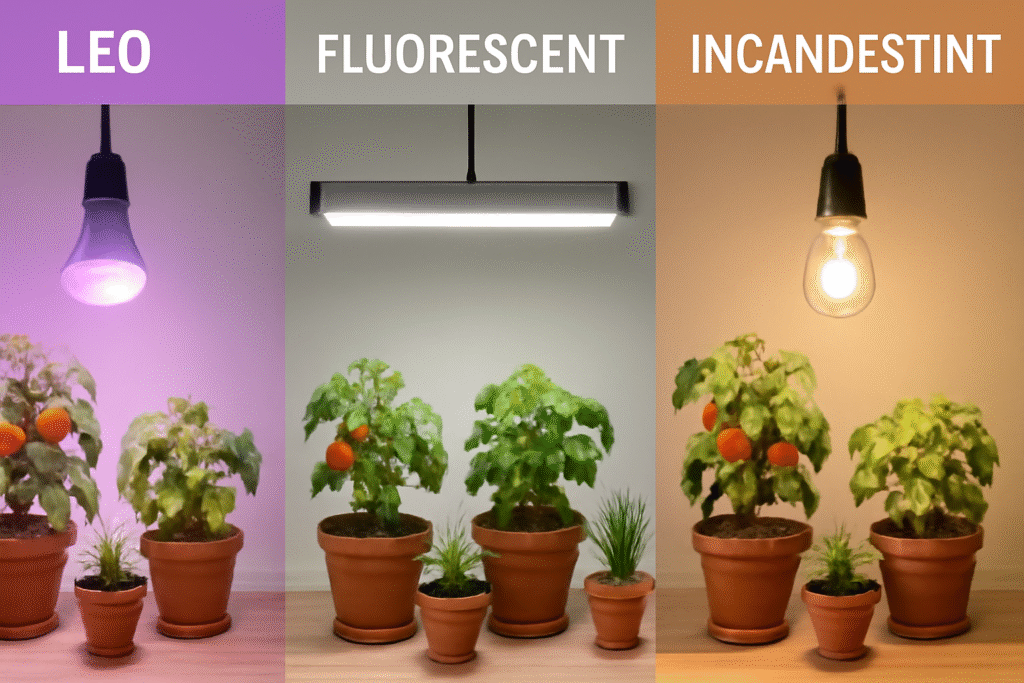
Benefits of Artificial Light for Plants
- Control Over Light Conditions
With artificial light, you can control the intensity, spectrum, and duration of light your plants receive. This is especially helpful when natural light is inconsistent or unavailable. You can adjust the light setup to suit different plant types and growth stages, ensuring they get just what they need. - Ideal for Low-Light Environments
If your home doesn’t get much sunlight, artificial light allows you to create a thriving environment for plants. It’s perfect for apartments, basements, or rooms with limited access to natural light. Grow lights provide the necessary light intensity to support healthy growth in these spaces. - Year-Round Growth
Unlike natural light, which fluctuates seasonally, artificial lights provide consistent light year-round. This is particularly helpful in regions with long winters or for anyone who wants to grow plants indoors during the colder months when natural sunlight is scarce.
Challenges of Artificial Light for Plants
- Energy Use and Cost
While LED lights are energy-efficient, they still come with a cost. Fluorescent bulbs are cheaper to run, but they may need to be replaced more often. It’s essential to weigh the long-term costs of energy and bulb replacement when setting up your artificial lighting system. - Light Burn from Intense Heat
Some artificial lights, especially incandescent bulbs, produce a lot of heat. If placed too close to your plants, they can burn the leaves. LEDs and fluorescent lights tend to produce less heat, but it’s still important to monitor your plants’ proximity to the light to avoid damage. - Initial Setup Cost
The cost of purchasing grow lights, fixtures, and timers can add up. However, this investment is usually worthwhile for the long-term benefits of year-round plant growth. It’s a good idea to choose energy-efficient lights, like LEDs, to minimize operational costs over time.
Tips for Using Artificial Light Effectively
- Choose the Right Light for Your Plants
Different plants have different light needs. For example, leafy green plants (like ferns) generally need cooler light (blue spectrum), while flowering plants (like tomatoes) thrive on warmer light (red spectrum). Full-spectrum LED grow lights are a great all-around option for most plants. - Position the Lights Properly
For best results, keep your artificial light about 6–12 inches above your plants. Ensure the light covers the entire plant to encourage uniform growth. If you’re using a grow light system, make sure to place it at the correct height and distance to avoid light burn. - Set a Timer
Plants need consistent light and darkness cycles to grow properly. A timer can help you control how long your grow lights stay on. Most plants need about 12-16 hours of light a day, but this can vary depending on the species. - Monitor Plant Health
Keep an eye on your plants and adjust the light intensity or duration if you notice signs of stress, such as yellowing leaves or leggy growth. These could be signs that your plants need more light or that the light is too close.
Which Plants Benefit Most from Artificial Light?
Artificial light is especially useful for plants that require high light but are kept indoors, such as:
- Herbs (basil, parsley, mint)
- Succulents and cacti
- Leafy greens (lettuce, spinach)
- Tropical plants (ferns, orchids)
In low-light areas, you can use artificial light to support a variety of plants, including snake plants, pothos, and peace lilies.
Natural Light vs. Artificial Light: Key Differences
When it comes to providing light for your plants, both natural and artificial light have their unique advantages and challenges. 
1. Light Quality: Full Spectrum vs. Customizable Light
- Natural Light:
The sun provides a full spectrum of light, including blue, red, and ultraviolet wavelengths. This broad range supports all aspects of plant growth, from healthy leaf production to blooming and fruiting. Natural light’s spectrum is unmatched, and plants thrive under sunlight as it closely mimics the conditions they’d experience in nature. - Artificial Light:
Artificial lights can replicate certain wavelengths, but most don’t offer the full spectrum that sunlight does. However, full-spectrum grow lights come close, offering the range of light plants need. One major advantage of artificial light is that you can adjust the spectrum to suit specific plant needs (e.g., more blue light for leafy plants, more red for flowering plants).
Verdict: Natural light wins for its full-spectrum, but with the right grow lights, artificial light can be customized to match your plants’ needs.
2. Light Intensity: Natural Power vs. Controlled Settings
- Natural Light:
Sunlight is incredibly powerful and can vary greatly depending on the time of day, season, and weather conditions. In the summer, plants receive intense, direct sunlight, which may be too much for some species. On cloudy days or in the winter, the intensity drops, which can slow down growth. - Artificial Light:
Artificial light allows you to control intensity with ease. You can choose the brightness level and how close or far the light source is from your plants, creating a stable, consistent environment. This means no surprise cloudy days or unpredictable shifts in light intensity.
Verdict: Artificial light offers more control, while natural light can sometimes be too intense or too weak depending on the circumstances.
3. Cost: Free vs. Investment
- Natural Light:
The sun is free! You don’t need to pay for sunlight, making it a cost-effective option, especially if you have access to good natural light in your space. You only need to worry about positioning your plants in the right spots and managing exposure. - Artificial Light:
Artificial lights come with upfront costs for purchasing bulbs, fixtures, and sometimes the installation of a lighting system. While LEDs are energy-efficient, you still have to account for electricity use over time, though it’s generally minimal with modern LED setups.
Verdict: Natural light is free, while artificial light requires a financial investment, though the cost of artificial lighting can be managed with energy-efficient solutions.
4. Availability: Sun vs. Consistent Light
- Natural Light:
Natural light is dependent on time of day, weather, and seasons. In winter, the sun is lower in the sky and daylight hours are shorter, which means your plants may not get enough light. Additionally, some spaces, like basements or rooms without windows, may not have access to natural light at all. - Artificial Light:
Artificial light is available 24/7, regardless of the weather or time of year. This makes it a reliable option for ensuring your plants get consistent light, especially in spaces with minimal natural sunlight or in winter months when daylight is limited.
Verdict: Artificial light is more reliable and consistent, while natural light depends on various factors like season and weather.
5. Environmental Impact: Green vs. More Energy Use
- Natural Light:
Sunlight is eco-friendly and sustainable—no energy is used to provide it. It’s the most natural and environmentally friendly option for your plants. - Artificial Light:
While modern LEDs are energy-efficient, they still require electricity. If you’re using artificial light extensively, especially in a large grow setup, the environmental impact can be greater. However, you can minimize this by choosing energy-efficient bulbs and using timers to ensure lights are only on when necessary.
Verdict: Natural light is the greener option, but energy-efficient artificial light can be a sustainable choice if used wisely.
6. Flexibility: Fixed vs. Customizable
- Natural Light:
You can’t adjust the natural light in your space. If your home faces the wrong direction, has limited windows, or experiences weather fluctuations, you may struggle to give your plants the consistent light they need. - Artificial Light:
Artificial lighting gives you complete flexibility. You can set up lights wherever needed and adjust the intensity, duration, and spectrum. This flexibility is especially useful for growing plants in areas that lack sufficient natural light or for those who want to experiment with different setups.
Verdict: Artificial light is far more flexible, giving you control over your plants’ lighting needs. Natural light, while ideal, is far less customizable.
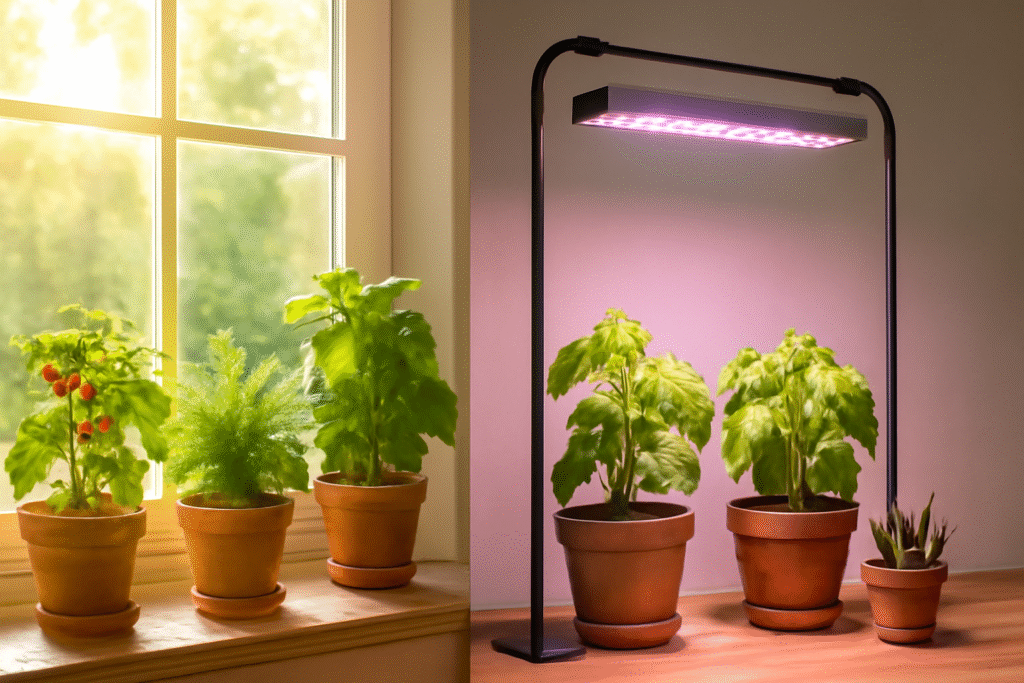
Which Light Is Best for Healthy Growth?
When deciding between natural light and artificial light for your plants, the right choice depends on several factors, including your plant’s needs, your living space, and the time of year. 
Natural Light: Best for Outdoor and Sun-Loving Plants
Natural light is the most ideal source for most plants because it offers a full spectrum of light, which supports all stages of growth. 
- Best for:
- Sun-loving plants like succulents, cacti, and many herbs.
- Tropical plants that thrive in warm, direct sunlight.
- Outdoor gardens that can naturally soak up sunlight throughout the day.
- Considerations:
- Consistency: Natural light can be inconsistent due to weather, seasons, and time of day. If your plants need a steady light source, consider supplementing with artificial light, especially in winter or during cloudy days.
- Risk of overexposure: While sunlight is powerful, too much of it can lead to leaf burns. Be sure to manage exposure carefully to avoid damage.
Pro Tip: If your home has limited sunlight, position plants near south or west-facing windows for optimal light exposure. If direct sunlight is too harsh, consider using sheer curtains to diffuse the light.
Artificial Light: Best for Low-Light Environments and Year-Round Growth
Artificial light is the perfect solution if you’re working with limited natural light or need to extend the growing season. Grow lights provide consistent, controlled lighting that can be adjusted to suit your plants’ needs.
- Best for:
- Low-light spaces: Basements, offices, and rooms with few windows.
- Plants that need extra light during winter months or in regions with long seasons of cloudy weather.
- Grow setups for specialized plants like herbs, leafy greens, and seedlings.
- Considerations:
- Initial investment: Setting up artificial light systems (e.g., LED or fluorescent bulbs) requires an initial investment. However, this investment pays off in consistent growth.
- Energy usage: While LEDs are energy-efficient, they still consume electricity. Consider using timers to regulate how long your grow lights stay on to minimize energy use.
Pro Tip: Full-spectrum LED grow lights are highly recommended for most indoor plants. They provide a light spectrum similar to natural sunlight, ensuring your plants get everything they need for healthy growth.
Which Light Should You Choose for Healthy Growth?
- If you have access to abundant natural light: Go for natural light. Many plants, especially sun-loving varieties, thrive best under sunlight. If your space offers plenty of direct sunlight, this is the most cost-effective and natural option for your plants.
- If you have limited natural light or need year-round growth: Artificial light is your best option. Grow lights offer flexibility and allow you to create the ideal growing conditions for your plants, regardless of the season or weather outside.
- For a balanced approach: Combine both!
Many plant owners find that using natural light for part of the day and supplementing with artificial lights during darker hours or in low-light areas creates the best environment for their plants.
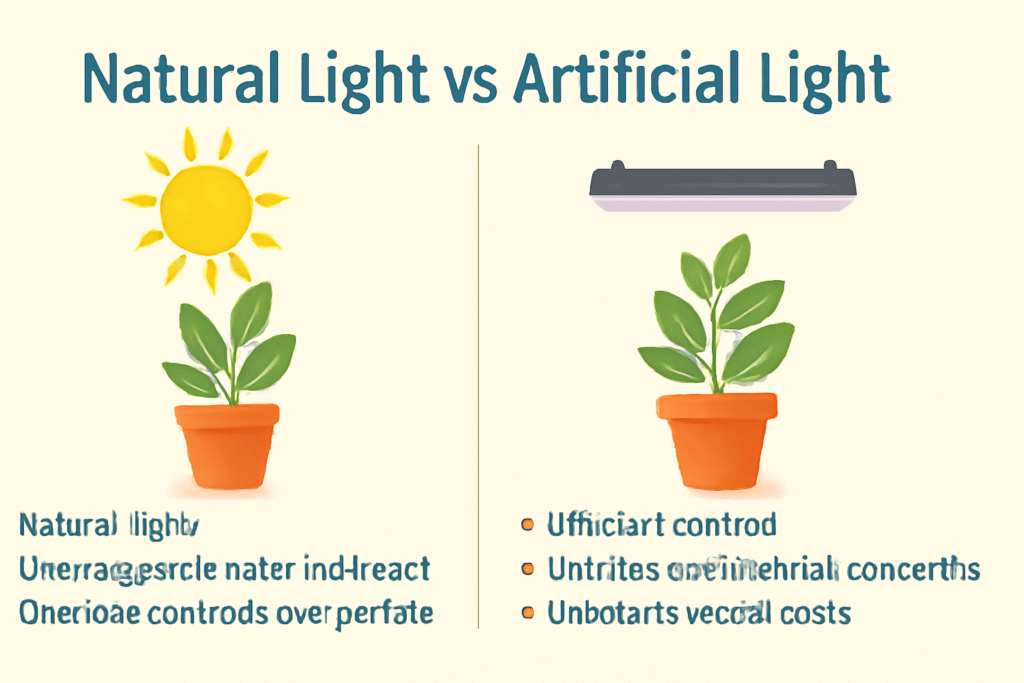
Practical Tips for Maximizing Light for Your Plants
Getting the right amount of light for your plants can sometimes be tricky, but with the right approach, you can create the ideal lighting conditions to help them thrive. Whether you’re relying on natural light or artificial grow lights, here are some practical tips to make the most of the light available to your plants.
Maximizing Natural Light for Indoor Plants
- Position Plants Near the Best Windows
The quality and quantity of natural light depend on where you place your plants. South-facing windows generally get the most sunlight throughout the day, while east-facing windows offer bright, morning light. West-facing windows give you afternoon sun, which can be intense.- Pro Tip: If you only have north-facing windows, try using a reflective surface (like mirrors or white walls) to bounce light back onto your plants.
- Rotate Your Plants Regularly
Plants grow toward the light. To prevent them from becoming lopsided, rotate them 180 degrees every week. This helps ensure even growth on all sides and prevents “leggy” plants stretching toward one side. - Use Sheer Curtains for Diffusion
Direct sunlight can sometimes be too harsh, especially for delicate plants. Sheer curtains or blinds can diffuse the light, making it gentler on your plants while still providing them with the energy they need. - Optimize Light During the Winter
In the winter months, when natural light is limited, place plants closer to windows. Consider using grow lights as a supplement during the shorter days and cloudy weather to ensure your plants get enough light to stay healthy.
Maximizing Artificial Light for Indoor Plants
- Choose the Right Grow Light for Your Plants
Not all artificial lights are created equal. When choosing grow lights, look for full-spectrum options that mimic natural sunlight. LED grow lights are highly energy-efficient and provide the necessary light spectrum for most plants.- Pro Tip: Choose a light temperature (measured in Kelvin) that suits your plants. For leafy greens, choose cool light (around 6,500K), while warm light (around 3,000K) is great for flowering plants.
- Proper Distance and Positioning
The distance between your grow lights and your plants matters. Too close and you risk burning your plants; too far, and they may not get enough light. Generally, keep LED lights about 6-12 inches above smaller plants and 12-24 inches for larger plants.- Pro Tip: If you’re using fluorescent lights, they should be kept about 2-4 inches above the plant.
- Use Timers for Consistency
Plants need a consistent light and dark cycle to thrive. Set up a timer for your grow lights to ensure your plants receive the correct amount of light each day. Most indoor plants benefit from 12-16 hours of light per day, but this can vary depending on the plant species.- Pro Tip: Use LED lights with built-in timers to save you time and ensure consistency.
- Monitor Plant Health Regularly
Keep an eye on your plants and make adjustments as needed. If you notice yellowing leaves or leggy growth, it might mean your plants aren’t getting enough light. On the other hand, if the edges of the leaves are crispy or scorched, your plants might be getting too much direct light. - Reflect Light to Maximize Efficiency
If you have limited space or light, use reflective materials like white walls, aluminum foil, or Mylar to bounce light back onto your plants. This can increase the light intensity without needing additional bulbs or fixtures.
General Tips for Both Light Sources
- Know Your Plant’s Light Needs
Different plants have different light requirements. High-light plants (e.g., succulents, cacti) need 6+ hours of direct sunlight or intense artificial light. Low-light plants (e.g., ferns, snake plants) thrive in indirect light or lower intensity artificial light.- Pro Tip: If your plant’s leaves start to yellow or become pale, it’s a sign they may need more light.
- Adjust for Seasonal Changes
As the seasons change, so does the amount of natural light. In winter, you may need to move your plants closer to windows or add artificial lighting to compensate for the reduced sunlight. Similarly, in the summer, adjust your plant’s position to prevent them from getting burned by too much direct sunlight.

Choosing between natural light and artificial light for your plants isn’t a one-size-fits-all decision—it depends on your space, plant type, and environmental conditions. 
Natural light, with its full spectrum and cost-free availability, is the best choice when you have access to abundant sunlight. However, its inconsistency due to weather, time of day, and season can sometimes be limiting. On the other hand, artificial light offers flexibility and consistency, making it the ideal solution for low-light spaces or year-round plant care. With the right grow lights, you can simulate the perfect conditions for healthy, vibrant growth, regardless of what the weather outside looks like.
To achieve the healthiest plants, it’s essential to understand your plant’s light requirements and adjust accordingly. 
By following the tips and insights in this article, you’ll be able to provide your plants with the perfect light, ensuring they stay healthy, strong, and vibrant for years to come. 
Frequently Asked Questions (FAQs)
1. Can plants survive with only artificial light?
Yes, plants can survive with only artificial light, especially when using full-spectrum grow lights. These lights mimic natural sunlight, providing the necessary wavelengths for photosynthesis. However, they may not grow as quickly or robustly as plants under natural light, but with proper setup, they can thrive indoors.
2. How many hours of light do my plants need each day?
Most plants need about 12-16 hours of light per day to thrive, depending on the species. Low-light plants require fewer hours, while high-light plants need more. A good rule of thumb is to provide your plants with consistent light and darkness cycles to mimic natural conditions.
3. What is the difference between natural and artificial light for plants?
Natural light provides a full spectrum of light and is ideal for plant growth, but it can be inconsistent. Artificial light, like LED or fluorescent grow lights, offers control over light intensity, duration, and spectrum, making it a reliable option for indoor plants or spaces with limited sunlight.
4. Can too much artificial light harm my plants?
Yes, excessive artificial light can harm your plants, causing leaf burn or stress. It’s important to use grow lights at the correct distance from plants and set timers to avoid overexposure. Always monitor your plants for signs like yellowing leaves or crispy edges to ensure they’re not getting too much light.
5. How do I know if my plants are getting enough light?
If your plants’ leaves turn yellow, become leggy, or stretch toward the light source, they may not be getting enough light. On the other hand, if their leaves are scorched or crispy, they might be getting too much light. Adjusting light intensity or repositioning your plants can help.
6. Should I use natural light or artificial light for indoor plants?
It depends on your space. If your plants have access to abundant, consistent natural light, that’s often the best option. However, if your home has limited sunlight or you want to grow plants year-round, artificial grow lights can provide the necessary light for healthy growth.
7. What type of artificial light is best for plants?
Full-spectrum LED lights are the best option for most indoor plants as they mimic natural sunlight and are energy-efficient. Fluorescent lights are also a good choice for low-light plants. Avoid using incandescent lights, as they produce too much heat and not enough useful light for plants.
8. Can I use artificial light for plants during the winter?
Yes, artificial light is a great solution during the winter months when natural sunlight is limited. Using grow lights can supplement the lower light levels and keep your plants healthy, allowing them to continue growing even in the darker, colder months.























